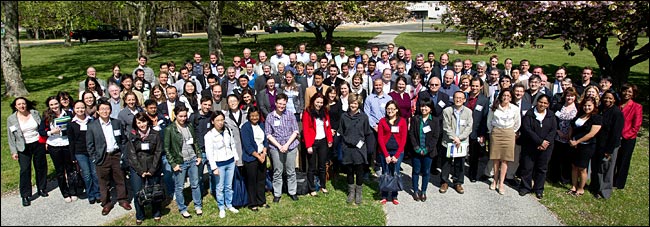Report on Operando-IV Conference
July 12, 2012
Brookhaven National Laboratory hosted the 4th International Conference on Operando Spectroscopy, Recent Developments and Future Perspectives in Spectroscopy of Working Catalysts from April 29 to May 3, 2012. This international conference is held every three years, and this was the first time the meeting was held in the United States.

The conference was attended by 157 researchers from 24 different countries. Indeed scientists from locales as diverse as South Africa, Brazil, Argentina, and many European countries were attracted to the conference by both the location and the content. A do-as-you-please bus tour to New York City was offered to conference attendees on the Sunday prior to the welcome reception. The weather cooperated and fantastic views from the top of the Empire State Building were reported.
The meeting began with a welcome reception on Sunday evening, featuring vendors from 11 different companies displaying their latest innovations and developments in scientific equipment needed for catalyst characterization studies. The conference proper began with a welcome from Sam Aronson, Director of BNL, before launching into a plenary talk from Bert Weckhuysen (Utrecht University, The Netherlands). There were sessions focused on different aspects of Operando spectroscopy, from latest developments in methodology and technique development, to applications in the catalysis of bioconversion technologies. Each morning and afternoon session began with a plenary talk, plenary speakers were as follows: Robert Schlögl (Fritz-Haber-Institute, Berlin, Germany), Jan-Dierk Grunwaldt (Karlsruhe Institute of Technology, Germany), Marco Daturi (CNRS, Caen, France), Angelika Brückner (Leibniz Institute for Catalysis, Rostock, Germany), and Peng Chen (Cornell University, NY). They each provided an overview of the state-of-the-art and the challenges in their area of expertise.
It is now well-established that catalysts structurally and electronically transform to the reaction environment and thus in order to truly understand the details of how a catalyst functions it is essential to study the catalyst when it is actually working, i.e. operando. The scientific talks and posters presented at the conference beautifully illustrated this point, and detailed the additional insight that can be gained by spectroscopically studying the catalyst in the reaction environment. The techniques used ranged from synchrotron-mediated techniques such as X-ray absorption spectroscopy, ambient pressure photoemission spectroscopy, and x-ray diffraction and tomography to FTIR, laser Raman and EPR. Examples were given of using multiple techniques simultaneously, and of innovative designs in the so-called reaction cells needed to combine the spectroscopy and catalysis.
Relaxation time was built into the schedule by an afternoon of wine tasting at two vineyards on the North Fork. Following the wine tasting was the conference banquet, held at The Vineyard in Aquebogue and featuring an elegant buffet and live jazz music, with time to socialize and discuss science.
The conference featured both oral and poster presentations. In order to provide increased visibility for the poster session, the student and postdoctoral researchers were invited to participate in a “Poster Slam.” They were allowed two minutes and one viewgraph to innovatively present the highlights of their work, and attract the conference attendees to visit their poster. All 22 students who participated in this fast-paced and fun event took the challenge to heart; one student even presented his two minutes in rhyming poetry! This event was compulsory for those students who wished to enter the best poster prize, kindly supported by the two journals ACS Catalysis and Physical Chemistry Chemical Physics. The poster judging committee had a difficult task given the quality of the work presented, but awarded the joint first prizes to Isabel Green (Univ. Virginia) and Dirk Holman (Leibniz Institute of Catalysis), the second prizes to Shilpa Agarwal (Univ. Twente) and Laure Braconnier (IFP Energies Nouvelles), and the third prizes to Samson Lai (Georgia Institute of Technology) and Javier Ruiz-Martinez (Utrecht University).
The conference was financially supported by the following companies, and they are thanked for their generous support. ExxonMobil, Bruker, Shell, BaySpec, FEI, UOP, PerkinElmer, Elsevier, Avantes, Harrick, Hiden Analytical, Horiba, Princeton Instruments, VAT, and VG Scienta. In addition, there was financial support from the Photon Sciences Directorate at BNL, which enabled us to invite our plenary speakers, and both Basic Energy Sciences at DOE and the National Science Foundation, which allowed us to provide discounted registration and travel support for student and postdoc attendance.
The conference ran smoothly and was ably supported by many BNL staff, including Gretchen Cisco, Kathy Nasta, Nancye Wright, Gladys Mackenzie, Mercy Baez, Corrine Messana, April Spencer, Peter Gross, Chris Cacavali, Ruth Comas, and Tiffany Bowman. Their tireless efforts ensured that all of the conference attendees left the lab with a good impression of Brookhaven, and of Long Island and New York. They are all graciously thanked for their efforts.
The next Operando Congress will be held in the Normandy area in France in May 2015.
2012-3230 | INT/EXT | Newsroom









